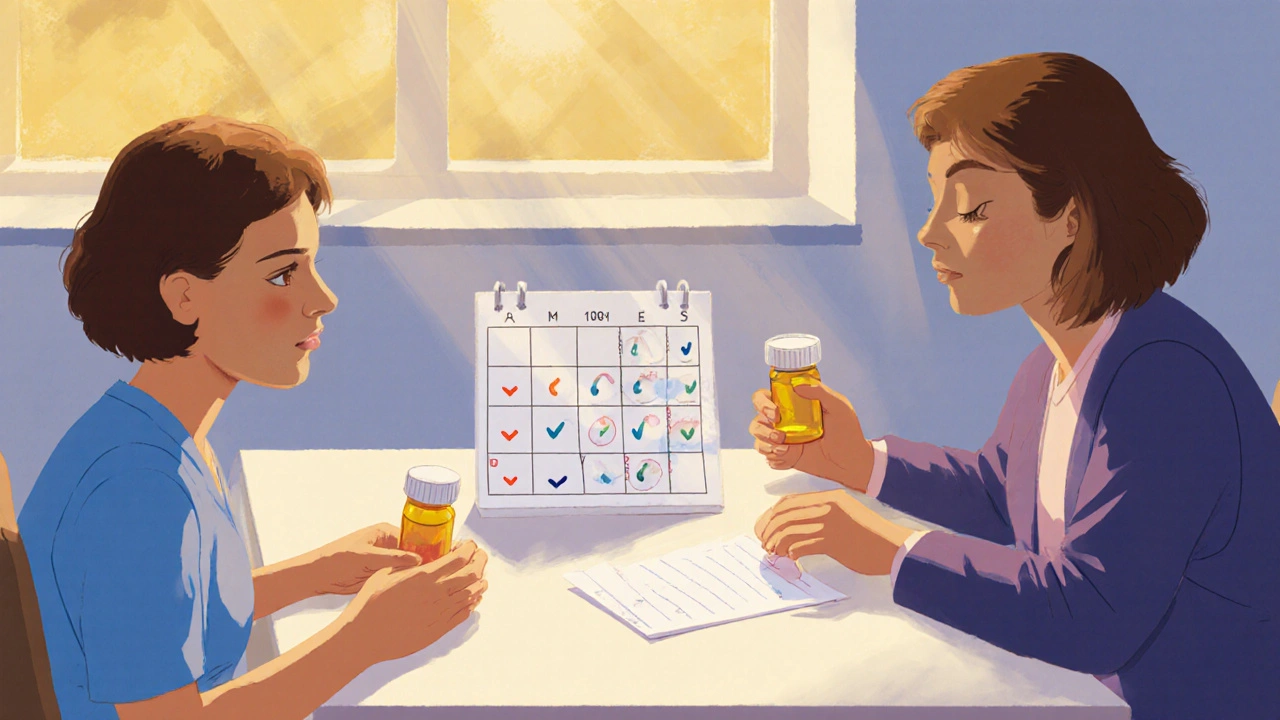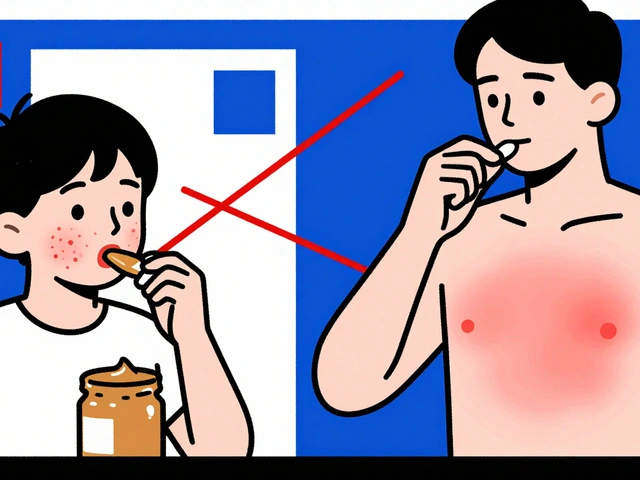Desyrel vs Alternatives: Medication Selector
Recommended Medications
Top Recommendation:
Detailed Comparison
| Medication | Primary Use | Sedation Level | Weight Impact | Cardiac Risk | Age Suitability |
|---|
Looking for a better sleep aid or mood booster? Desyrel comparison has you wondering whether the drug you’ve heard about is truly the best fit, or if there’s a safer, more effective option out there. In this guide we break down how Desyrel (Trazodone) stacks up against the most common alternatives, covering how each works, typical dosing, side‑effects, and who should consider switching.
Quick Summary
- Desyrel (Trazodone) is a serotonin antagonist‑reuptake inhibitor used for depression and off‑label for insomnia.
- Alternative meds like mirtazapine, amitriptyline, quetiapine, and sertraline offer different mechanisms and side‑effect profiles.
- Choose an alternative based on your primary symptom (depression, anxiety, or sleep), tolerability, and any co‑existing health conditions.
- Switching requires a taper plan and close monitoring for withdrawal or serotonin syndrome.
- Always discuss changes with a prescriber; self‑adjusting doses can be risky.
How Desyrel (Trazodone) Works
When considering sleep aid options, Desyrel (Trazodone) is a serotonin antagonist and reuptake inhibitor (SARI) commonly prescribed for depression and off‑label for insomnia. It blocks certain serotonin receptors while increasing overall serotonin levels, which helps lift mood and can produce a sedating effect at lower doses. Typical bedtime doses range from 25mg to 100mg, far lower than the 150‑300mg doses used for depression.
Because it hits multiple serotonin pathways, Desyrel can cause side effects like daytime drowsiness, dry mouth, and a rare but notable risk of priapism (prolonged erection). Its half‑life is about 6‑8hours, meaning the drug usually clears the system by the next morning, but residual sedation can still affect daytime alertness.

Major Alternatives Overview
Mirtazapine is a tetracyclic antidepressant that works by antagonizing central alpha‑2 adrenergic receptors and certain serotonin receptors. It’s often chosen for patients who struggle with insomnia because it has strong sedating effects at lower doses (15‑30mg). However, it can cause significant weight gain and increased appetite.
Amitriptyline belongs to the tricyclic antidepressant class and blocks the reuptake of norepinephrine and serotonin. At low doses (10‑25mg), it’s a classic sleep aid, but its anticholinergic side effects-dry mouth, constipation, blurred vision-can be problematic, especially for older adults.
Quetiapine is an atypical antipsychotic that antagonizes dopamine D2 and serotonin 5‑HT2A receptors. Off‑label, it’s used for insomnia because of its strong antihistamine action. Risks include metabolic changes, dizziness, and a higher chance of extrapyramidal symptoms.
Sertraline is a selective serotonin reuptake inhibitor (SSRI) widely prescribed for depression and anxiety. While not primarily sedating, it can be combined with a low‑dose hypnotic for patients needing both mood stabilization and sleep. Common side effects are gastrointestinal upset and sexual dysfunction.
Other agents such as Insomnia refers to difficulty falling or staying asleep, often linked to mood disorders and Depression is a mood disorder characterized by persistent sadness, loss of interest, and functional impairment also influence which medication makes the most sense.
Side‑Effect Profile Comparison
| Medication | Primary Indication | Typical Bedtime Dose | Onset (hours) | Common Side Effects | Special Considerations |
|---|---|---|---|---|---|
| Desyrel (Trazodone) | Depression, insomnia (off‑label) | 25‑100mg | 0.5‑2 | Drowsiness, dry mouth, priapism (rare) | Gentle on weight, caution with cardiac conduction issues |
| Mirtazapine | Depression, insomnia | 15‑30mg | 1‑3 | Weight gain, increased appetite, sedation | Useful for patients needing appetite stimulation |
| Amitriptyline | Depression, neuropathic pain, insomnia | 10‑25mg | 1‑2 | Dry mouth, constipation, blurred vision, orthostatic hypotension | Avoid in elderly, cardiac monitoring required |
| Quetiapine | Schizophrenia, bipolar, insomnia (off‑label) | 25‑50mg | 2‑4 | Metabolic changes, dizziness, daytime sedation | Watch blood glucose & lipid profile |
| Sertraline | Depression, anxiety, OCD | 25‑50mg (combined with hypnotic) | 4‑6 | GI upset, sexual dysfunction, insomnia (initially) | Long‑term use well studied; less sedating |

Choosing the Right Option: Decision Guide
Here’s a quick way to narrow down the best fit:
- Primary Goal: If sleep is the main issue, mirtazapine or low‑dose amitriptyline often give the deepest sedation. If mood elevation is paramount, sertraline or Desyrel may be preferable.
- Weight Concerns: Avoid mirtazapine if you’re watching your waistline; it’s notorious for weight gain.
- Cardiac Health: Amitriptyline and high‑dose trazodone can affect heart rhythm. Choose sertraline or low‑dose mirtazapine instead.
- Metabolic Profile: Quetiapine can raise blood sugar and lipids-skip it if you have diabetes or metabolic syndrome.
- Age Factor: Elderly patients tolerate low‑dose trazodone or sertraline better than tricyclics because of lower anticholinergic burden.
- Drug Interactions: All serotonin‑acting meds carry a risk of serotonin syndrome when combined with other serotonergic agents (e.g., certain migraine meds, St. John’s Wort).
Ask yourself which of these criteria matter most to you, then match them with the medication that meets the most points without raising red flags.
Switching Safely
Never stop a prescription cold turkey. Most antidepressants, including Desyrel, benefit from a taper:
- Reduce the dose by 25% every 1‑2weeks, monitoring for rebound insomnia or mood dip.
- If moving to a different class (e.g., from trazodone to a SSRI), a brief washout period of 2‑3days can reduce serotonin syndrome risk.
- Keep a symptom diary: note sleep quality, mood swings, and any new side‑effects.
- Stay in touch with your prescriber; dosage tweaks are often needed during the first month.
For patients on multiple psychotropic drugs, a coordinated taper plan overseen by a psychiatrist or a pharmacist ensures safety and minimizes withdrawal.
Frequently Asked Questions
Can I use Desyrel purely as a sleep aid?
Yes, many doctors prescribe low‑dose Desyrel (25‑50mg) at bedtime for insomnia. The dose is much lower than what’s used for depression, which reduces the risk of mood‑related side effects. However, you should still discuss this off‑label use with your prescriber, especially if you have heart problems or are taking other serotonergic drugs.
Why does Desyrel sometimes cause erection problems?
Priapism is a rare side effect linked to trazodone’s strong alpha‑adrenergic blocking activity, which can affect blood flow to the penis. It occurs in less than 1% of users but requires immediate medical attention if an erection lasts longer than 4hours.
Is mirtazapine better for weight loss?
Actually, mirtazapine is associated with weight gain, not loss. It stimulates appetite by blocking histamine receptors. If weight control is a priority, an SSRI like sertraline or a low‑dose trazodone may be preferable.
Can I combine an antidepressant with an over‑the‑counter sleep aid?
Combining serotonergic antidepressants with OTC antihistamine sleep aids (e.g., diphenhydramine) can increase sedation and anticholinergic load. Always check with a healthcare professional before mixing, especially if you’re already on a drug like trazodone that has sedating properties.
How long does it take for sertraline to improve sleep?
Sertraline isn’t primarily a sleep medication, so improvement in sleep usually follows mood improvement. Most patients notice better sleep after 4‑6weeks of consistent dosing, though some may feel initial insomnia during the first few days.






Rahul yadav
October 8, 2025 AT 15:53Wow, this rundown really hits home for anyone juggling sleep and mood issues! 🌙✨ I love how it breaks down each drug’s vibe, especially the gentle touch of Desyrel on weight. If you’re feeling foggy in the daytime, try the low‑dose tip and watch the sedation melt away. Stay kind to yourself while you experiment – you’ve got this! 😊
Dan McHugh
October 8, 2025 AT 15:55Looks fine.
Sam Moss
October 8, 2025 AT 15:56Reading through this comparison feels like taking a guided tour through a pharmacy garden, each plant humming its own medicinal lullaby. First, the author paints Desyrel as the modest gardener, sprinkling serotonin with a light hand, enough to coax the night’s curtains to close without weighing down the morning sun. Then, the bold mirtazapine strides in like a heavyweight champion, promising deep sleep at the cost of a banquet‑sized appetite and a pillow‑filled waistline. Amitriptyl‑ine waltzes in, a vintage vinyl record of tricyclics, its anticholinergic notes echoing through dry mouths and dizzy rises, a risky dance for the elderly but a reliable lullaby for those who can handle the tempo. Quetiapine, the outsider, crashes the party with its antipsychotic swagger, delivering sedation that can feel like a dense fog, yet dragging metabolic baggage behind it. Sertraline, the reliable commuter, slides in on a low‑profile bike, offering steady mood uplift with a sidecar of occasional insomnia at the start, but otherwise keeping the journey smooth.
What truly shines is the decision matrix – a checklist that feels like a personal compass. If weight is a mountain you cannot climb, steer clear of mirtazapine; if cardiac rhythm is a fragile drum, give the high‑dose trazodone a respectful nod and perhaps favor sertraline or low‑dose trazodone instead. The author wisely reminds us that tapering is not a sprint but a slow walk down a steep hill, urging patients to keep a symptom diary – a practice that can be as illuminating as a lantern in a dark hallway.
In the end, the guide does more than list side effects; it weaves a narrative about personal priorities, encouraging the reader to match their unique health portrait with the medication that colors it best. For anyone standing at the crossroads of sleep and mood, this piece offers both a map and a friendly hand to hold.
Suzy Stewart
October 8, 2025 AT 15:58Great job outlining the key points – the table makes it super clear! 👍 Just remember to double‑check dosage ranges when switching meds. 😊
Traven West
October 8, 2025 AT 16:00Desyrel is low‑key, but the side‑effects list is a nightmare.
Jonny Arruda
October 8, 2025 AT 16:00True, the priapism risk is rare but worth noting.
Melissa Young
October 8, 2025 AT 16:03Listen, if you’re all about American pharma supremacy, you’d just slam down the newest antipsychotic and ignore the cheap generics. The market’s full of hype, and the “best” drug is whatever the big pharma lobby pushes. Don’t be fooled by the so‑called “balanced” profiles – they’re marketing fluff. Get the facts, not the spin.
SHASHIKANT YADAV
October 8, 2025 AT 16:05Interesting read! 😊 I’m curious about how the cardiac risks compare in real‑world data – any thoughts?
Ryan Pitt
October 8, 2025 AT 16:06Keep the optimism flowing – you’ll find the right fit!
Jami Johnson
October 8, 2025 AT 16:08This guide reminds us that medicine is as much an art as a science. While the tables present cold data, the lived experience of each patient adds color and depth – the same dose can feel like a gentle tide for one person and a crashing wave for another. Philosophically, we must respect the subjective narrative that each individual brings to the treatment table, honoring both empirical evidence and personal testimony. In practice, that means a collaborative dialogue, where the clinician listens, the patient shares, and together they craft a regimen that aligns with both physiological needs and existential goals. It’s a dance of trust, adjustment, and mindful observation.
May we all approach our medication decisions with humility and curiosity.
Kasey Krug
October 8, 2025 AT 16:10The article is decent, but it glosses over the real challenge of tapering antidepressants safely.